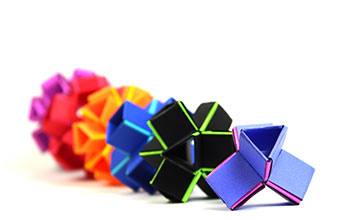Multimedia Gallery
3-D material with controllable shape and size (Image 5)
Harvard University researchers have designed a new type of foldable material that is versatile, tunable and self actuated. This image shows snapology models based on platonic solids. [Image 5 of 5 related images. Back to Image 1.]
More about this image
A research team at Harvard University has designed a new type of foldable material that is versatile, tunable and self actuated. It can change size, volume and shape, and can fold flat to withstand the weight of an elephant without breaking, and pop right back up to prepare for the next task.
"We’ve designed a three-dimensional, thin-walled structure that can be used to make foldable and reprogrammable objects of arbitrary architecture, whose shape, volume and stiffness can be dramatically altered and continuously tuned and controlled," said Johannes T. B. Overvelde, a graduate student in the lab of Katia Bertoldi, the John L. Loeb Associate Professor of the Natural Sciences at the Harvard John A. Paulson School of Engineering and Applied Sciences (SEAS).
Inspired by an origami technique called snapology, the material is made from extruded cubes with 24 faces and 36 edges. Like origami, the cube can be folded along its edges to change shape. The researchers say the cube can be deformed into many different shapes by folding certain edges, which act like hinges. The team embedded pneumatic actuators into the structure, which can be programmed to deform specific hinges, changing the cube’s shapes and size, and removing the need for external input.
The team connected 64 of these individual cells to create a 4x4x4 cube that can grow, and shrink, change its shape globally, change the orientation of its microstructure and fold completely flat. As the structure changes shape, it also changes stiffness -- meaning one could make a material that’s very pliable or very stiff using the same design. These actuated changes in material properties adds a fourth dimension to the material.
The work was supported by the National Science Foundation (NSF) (grants DMR 14-20570, CNS 11-49458, DMR 14-20570 and CMMI 11-49456).
To learn more about this research, see the NSF News From the Field story A foldable material that can change size, volume and shape. (Date image taken: 2015; date originally posted to NSF Multimedia Gallery: Dec. 5, 2018)
Credit: Image courtesy of Johannes Overvelde/Harvard SEAS
See other images like this on your iPhone or iPad download NSF Science Zone on the Apple App Store.
Images and other media in the National Science Foundation Multimedia Gallery are available for use in print and electronic material by NSF employees, members of the media, university staff, teachers and the general public. All media in the gallery are intended for personal, educational and nonprofit/non-commercial use only.
Images credited to the National Science Foundation, a federal agency, are in the public domain. The images were created by employees of the United States Government as part of their official duties or prepared by contractors as "works for hire" for NSF. You may freely use NSF-credited images and, at your discretion, credit NSF with a "Courtesy: National Science Foundation" notation.
Additional information about general usage can be found in Conditions.
Also Available:
Download the high-resolution JPG version of the image. (3.8 MB)
Use your mouse to right-click (Mac users may need to Ctrl-click) the link above and choose the option that will save the file or target to your computer.



